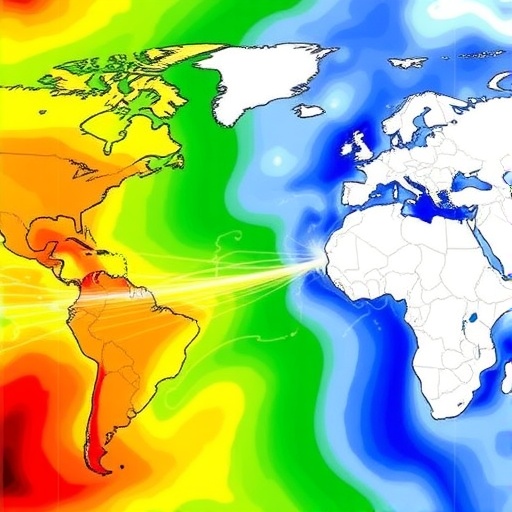As climate change continues to shape our planet, one of the most significant features that researchers are closely monitoring is the behavior of jet streams. These narrow bands of strong westerly winds in the mid-latitudes are essential elements in the Earth’s atmospheric circulation, influencing weather patterns and climate. Recent studies have brought to light the seasonally and regionally varying drivers behind the shifting jet streams, shedding light on the complex interplay of factors contributing to this phenomenon. With models forecasting a potential poleward shift of the jet streams in the coming decades, understanding these dynamics has never been more critical.
The eddy-driven jet streams are inherently dynamic, fluctuating not just from year to year but also across seasons. They are influenced by various climatic factors, including changes in Earth’s surface temperatures, sea ice extent, and atmospheric pressure patterns. The projected poleward shift of the jet streams, anticipated to range from 0° to 2° latitude by the century’s end under high-emissions scenarios, raises critical questions about the future of regional climates. Each model provides a different perspective, leading to substantial uncertainty surrounding future atmospheric conditions.
Particularly noteworthy is the observation of a statistically significant poleward shift of the summertime austral jet, approximately 0.3° per decade. This trend stands out against the backdrop of natural variability and demonstrates a concerning correlation with anthropogenic activities. As greenhouse gas emissions continue to rise, the alterations to jet stream behavior appear increasingly likely to bring about pronounced changes in weather patterns globally. However, attributing specific changes solely to human-induced factors remains complex due to the multitude of interacting elements in the climate system.
Modeling future jet stream behavior presents considerable challenges. Differences in model structures, parameterizations, and input data lead to substantial variations in projections among climate models. These discrepancies highlight the necessity for ongoing research to identify the mechanisms driving these variations more accurately. Understanding the regional and seasonal nuances of jet streams is particularly essential, as projections that aggregate data on a global scale can obscure critical local changes and trends.
Research into the seasonal and regional impacts of jet streams has been disproportionately focused on winter months, particularly in the North Atlantic. This imbalance indicates a gap in our overall understanding of jet stream behavior during other seasons, such as spring and autumn. These transitional seasons are vital as they can reveal shifts in climatic norms, potentially impacting agricultural practices and ecological systems that are finely tuned to such changes. By prioritizing research in these neglected areas, scientists will better inform predictions and impact assessments related to future climate scenarios.
The complexities of the drivers behind jet stream alterations further complicate our understanding. Factors such as stratospheric warming, boundary layer dynamics, and sea surface temperature anomalies can all influence jet stream dynamics. Disentangling these effects requires a rigorous examination of multi-scale interactions within the climate system. As interdisciplinary research grows, collaborations among meteorologists, oceanographers, and environmental scientists are likely necessary to construct a complete picture of the jet stream behavior.
Continued observations are crucial in validating climate models and assessing their projections against real-world data. Reanalysis records since 1979 serve as invaluable resources for understanding long-term trends in jet streams. These datasets provide insights into historical patterns, allowing researchers to better grasp the magnitude and nature of changes occurring in jet stream behavior. However, significant internal variability presents challenges for establishing direct correlations between specific anthropogenic factors and observed jet stream trends.
Climate models projected that the warming atmosphere would lead to stronger jet streams, but recent empirical findings suggest that the reality may be more nuanced. Changes in sea ice cover, as well as alterations in land surface conditions, can contribute to variations in how jet streams operate. In particular, the documentation of changing conditions in the Arctic—the so-called Arctic amplification—suggests a complicated relationship between polar changes and mid-latitude atmospheric dynamics.
Given the overarching uncertainty surrounding future jet stream trajectories, the need for targeted climate research becomes ever more pressing. The influence of jet streams on phenomena such as extreme weather events, droughts, and heavy precipitation cannot be overstated. Regions may experience novel climate conditions not previously reflected in historic trends. For instance, areas that traditionally relied on predictable seasonal weather may suddenly find themselves subject to erratic shifts due to altered jet patterns.
As global temperatures continue to rise, the jet streams will likely evolve further, necessitating adaptive measures across various sectors. Agriculture, water management, and urban planning must account for potential changes in precipitation patterns, seasonal temperature fluctuations, and the timing of weather events. Cities and regions should start preparing for these shifts to mitigate impacts on their infrastructures and resources effectively.
In conclusion, the study of jet streams presents an ongoing and evolving challenge fueled by climate change. The interactions between anthropogenic factors, atmospheric dynamics, and natural variability demand urgent attention from the scientific community. With significant implications for regional climates and weather patterns, it is essential to deepen our understanding of these complex systems. By amplifying research efforts and focusing on the full spectrum of seasonal variations, scientists can illuminate the pathways forward to address the challenges posed by climate change effectively.
Subject of Research: Jet Stream Changes and Drivers
Article Title: Seasonal and regional jet stream changes and drivers.
Article References:
Breul, P., Ceppi, P., Simpson, I.R. et al. Seasonal and regional jet stream changes and drivers.
Nat Rev Earth Environ (2025). https://doi.org/10.1038/s43017-025-00749-9
Image Credits: AI Generated
DOI:
Keywords: Jet Streams, Climate Change, Atmospheric Dynamics, Regional Climate, Extreme Weather, Anthropogenic Forcing.




